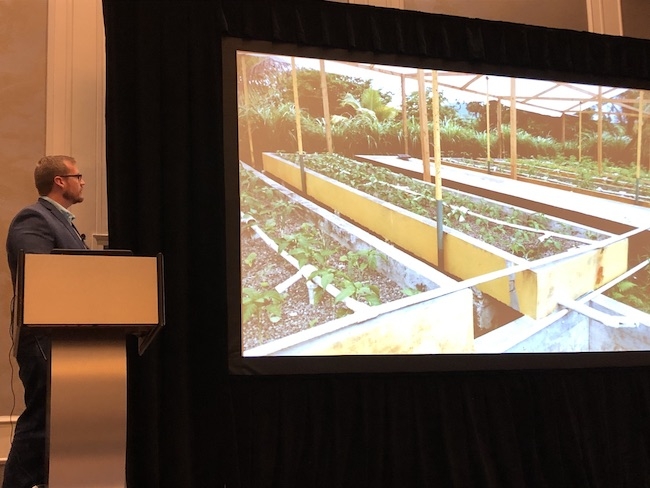
Features
Recirc
Keeping it simple
NEW ORLEANS – Aquaponics was a big feature at Aquaculture 2019 held in this city March 7-11, with presenters highlighting the system's potential for addressing the world's food security challenges.
March 14, 2019 By Mari-Len De Guzman
 Allen Patillo shows a photo of the aquaponic farm developed in Jamaica through the IACA project
Allen Patillo shows a photo of the aquaponic farm developed in Jamaica through the IACA project “We are not here because we want to know aquaponics; we are here because we want to grow food,” urban farming advocate George Brooks told attendees at his session, “Applying design thinking to new aquaponic system development.”
Brooks is the founder and president of NxT Horizon Group, which specializes in AgTech (agricultural technology) to build food production systems, including aquaponics and urban agriculture.
“The world needs more fish and we think aquaponics is a way to accomplish that task. The problem is that aquaponics is fragile,” Brooks said, adding that for communities to take advantage of aquaponics as a sustainable food production system, the fragility aspect has to be resolved.
Presenting the concept of ‘design thinking’ – empathize, define, ideate, prototype, test – Brooks said this approach to producing an aquaponic system will help manage the complexity of such systems when applied to a community or urban setting.
Related: Cozy with koi: How this fish can be an ideal species for aquaponics systems
According to the Interaction Design Foundation, design thinking is a “design methodology that provides a solution-based approach to solving problems. It’s extremely useful in tackling complex problems that are ill-defined or unknown, by understanding the human needs involved, by re-framing the problem in human-centric ways, by creating many ideas in brainstorming sessions, and by adopting a hands-on approach in prototyping and testing.”
In his aquaponics session, Allen Patillo presented a project in Jamaica to develop a US$20,000 medium-size commercial aquaponic system. Patillo is the aquaponics technical director for the Increasing Access to Climate-smart Agriculture (IACA) project by INMED Caribbean, a not-for-profit international development organization that creates pathways for disadvantaged children and families to achieve self-reliance and success.
The IACA project aims to increase economic opportunities for small-scale farmers while reducing vulnerability to climate change and minimizing adverse environmental impacts. It focused on making aquaponics a commercially viable technology for small and medium-scale Jamaican farmers, including women, youth and disabled farmers, while improving their market access and resilience to climate change.
Training was a vital element for the success of the project, Patillo said. The target group were small to medium-scale farmers, with traditional or greenhouse farming experience and a track record of successful business operations.
“We wanted to make sure we are picking people who are good candidates to get this thing done,” Patillo said.
The training program included interactive online modules, hands-on workshops, and internships that serve as prequalification for financing with local banks, Patillo explained in his presentation abstract.
The IACA aquaponic system used an ebb and flow design with nine grow beds that are 20 feet long and four feet wide. Keeping the system design and operation simple helps keep the costs down without any expensive components to keep up with, Patillo said.
In addition to Brooks and Patillo, 10 other presenters presented their aquaponics studies and research, including an assessment of the technical and economic feasibility of a portable aquaponic system by Peace Chemis Mnelemba of the Department of Aquaculture and Fisheries Science at Lilongwe University of Agriculture Natural Resources in Lilongwe, Malawi.
The study involved an experiment using lettuce as a crop and Oreochromis shiranus as the fish species. The experiment yielded a conclusion that a portable aquaponic system using locally available materials is feasible. The fish in the system had a survival rate of 96 percent, while the mean weight gain was 19 grams for the fish and 204 grams for the lettuce in 42 days.
Print this page
Advertisement
- Miami Bluehouse on track to build massive land-based salmon farm
- Discover the benefits of aquaponics at RAStech 2019!





